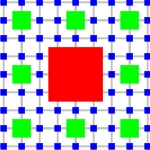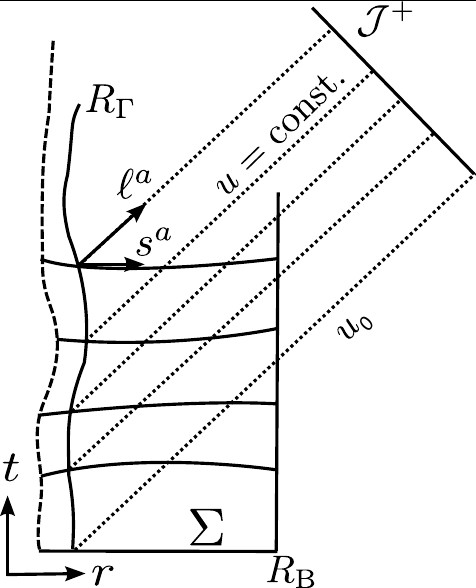Codes
Below is a list of codes that I have (co-)developed and that I am using.
The Llama multiblock code
The Lla ma code provides different multipatch systems that can be used in general relativistic hydrodynamic and spacetime evolution codes that are based on Cactus. More specifically, the simulation domain is covered by a set of overlapping grid patches with local coordinates each. This allows for topologically adapted grids and can result in a vast improvement of computational efficiency. Information between patches is communicated via interpolation. I am co-author and maintainer of this software.
ma code provides different multipatch systems that can be used in general relativistic hydrodynamic and spacetime evolution codes that are based on Cactus. More specifically, the simulation domain is covered by a set of overlapping grid patches with local coordinates each. This allows for topologically adapted grids and can result in a vast improvement of computational efficiency. Information between patches is communicated via interpolation. I am co-author and maintainer of this software.
The Einstein Toolkit
The Einstein Toolkit is a set of publicly available Cactus programs (“thorns”) that provide the capability of solving the fully non-linear Einstein equations and ideal general relativistic magnetohydrodynamics. I am one of the main developers of the magnetohydrodynamics module “GRHydro”. I use the Einstein Toolkit in my recent work on core-collapse simulations.
Toolkit is a set of publicly available Cactus programs (“thorns”) that provide the capability of solving the fully non-linear Einstein equations and ideal general relativistic magnetohydrodynamics. I am one of the main developers of the magnetohydrodynamics module “GRHydro”. I use the Einstein Toolkit in my recent work on core-collapse simulations.
The SIMsalabim Simulation Framework
SIMsalabim is a next generation high-performance simulation framework that supports massively distributed computations using task-based scheduling. Efficiently making use of large (>100,000 cores) distributed heterogeneous computational resources with multiple coupled numerical schemes / algorithms poses a serious challenge. To overcome starvation bottlenecks, SIMsalabim provides a distributing scheduling mechanism that is based on work stealing. Minimal assumptions are made about the actual computation. This framework is not limited to simulations. It is designed such that it runs in heterogeneous environments. I am the author of this software package.
The Cactus Computational Toolkit
 Cactus is a framework for solving numerical problems on a variety of different computer platforms. It is the basic code frame for developing my simulation codes.
Cactus is a framework for solving numerical problems on a variety of different computer platforms. It is the basic code frame for developing my simulation codes.
The Carpet Adaptive Mesh-Refinement Driver
 Carpet is an adaptive mesh refinement driver for Cactus. It also provides the basic multi-map infrastructure for Llama. I am involved in testing, bugfixing, and enhancing parts of this code.
Carpet is an adaptive mesh refinement driver for Cactus. It also provides the basic multi-map infrastructure for Llama. I am involved in testing, bugfixing, and enhancing parts of this code.
The VisIt Reader for Carpet
VisIt is a freely a vailable state-of-the-art parallel visualization software originally developed by the Department of Energy (DEO) Advanced Simulation and Computing Initiative (ASCI). I am author and maintainer of a VisIt database plugin that allows users to read in Cactus/Carpet HDF5 data output.
vailable state-of-the-art parallel visualization software originally developed by the Department of Energy (DEO) Advanced Simulation and Computing Initiative (ASCI). I am author and maintainer of a VisIt database plugin that allows users to read in Cactus/Carpet HDF5 data output.
The PITT Nullcode and Cauchy-characteristic extraction
 The PITT Nullcode was originally developed at the University of Pittsburg and is now part of the Einstein Toolkit. It implements characteristic evolutions of the Einstein equations in 3D along null hypersurfaces. Radial compactification allows the inclusion of null infinity on the computational grid. This code provides the ability to determine gravitational radiation unambiguously and free of gauge effects at future null infinity and for general numerical spacetimes such as binary black hole mergers or stellar core collapse. I am a co-author and maintainer of this software.
The PITT Nullcode was originally developed at the University of Pittsburg and is now part of the Einstein Toolkit. It implements characteristic evolutions of the Einstein equations in 3D along null hypersurfaces. Radial compactification allows the inclusion of null infinity on the computational grid. This code provides the ability to determine gravitational radiation unambiguously and free of gauge effects at future null infinity and for general numerical spacetimes such as binary black hole mergers or stellar core collapse. I am a co-author and maintainer of this software.
The pyGWDataAnalysis package
The pyGWDataAnalysis package is a set of freely available python classes and functions that help post-processing numerical relativity simulation output. In particular, it is most useful for gravitational wave related analysis. I am author and maintainer of this package.
